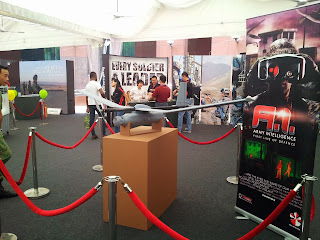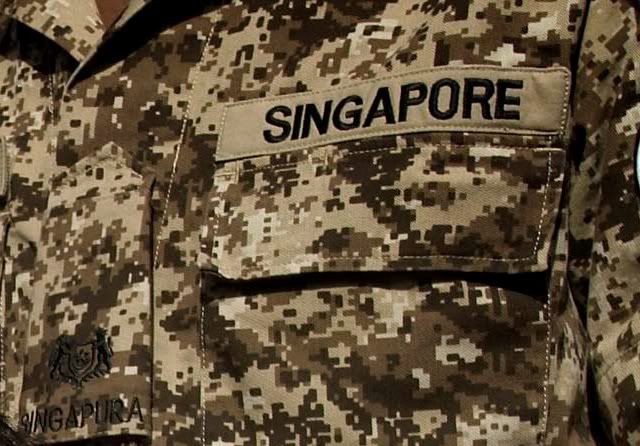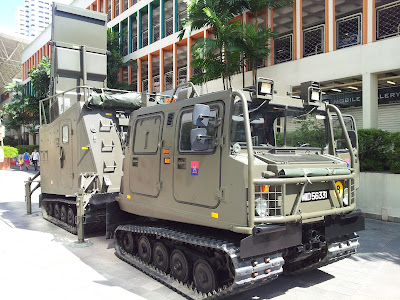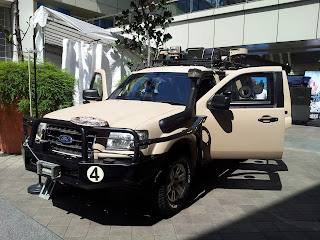Informed Defence is a Singapore-based blog commenting on defence and related topics, including foreign affairs, soldiering and politics. The views expressed on this blog are the author's personal views, and do not represent that of any other organization.
Thursday 17 October 2013
RSAF Museum - a new start in Changi?
The three Singaporean armed services operate their own heritage museums - the Air Force one opened first, followed by the Army Museum near the Discovery Centre (which used to focus on showcasing the military in an earlier incarnation), and the Navy Museum at the Changi naval base.
The Air Force museum first opened on Changi Air Base in 1988, but moved to Paya Lebar Air Base (PLAB) in 1990. The museum has seen some renovation and renewal in its 23-year career at PLAB - a scale model of Tengah Air Base was added, and the "Operations" segment has expanded along with the RSAF's remit, for example.
However, the museum itself does seem rather elderly - the video displays are dated, more multimedia could be added in lieu of the static displays to engage viewers more actively, and it hardly features in promotional material these days. In fact, the Museum's website (with a hopeful email attached for inquiries on tours and school visits) has not been updated since 2010.
With the recently announced plan to move PLAB's operations to Changi, one wonders whether the Air Force museum will return there as well.
Your author spent some good afternoons there over the years; while it might not have changed much, admission was free and it certainly was an exciting place for a young boy, with aircraft, helicopters and a Bloodhound on display and plenty of air force history and knick-knacks.
With PLAB closing, there seems little hope that the RSAF Museum will be rejuvenated in its current location - perhaps it will see a new lease of life back in Changi.
Friday 27 September 2013
Belated - SAF Afghanistan exhibition at Takashimaya
The Guards' new Light Strike Vehicle.
(unfortunately, no pictures of the LSV with weapons fitted have surfaced so far.)
Pegasus Singapore Light Weight Howitzer - implicated in India!
Once more - the Bv 206 Weapon Locating Radar. (The author regrets not checking if it was the same vehicle as the one displayed at Toa Payoh HDB Hub, MID 56331)
A Singapore-made Skyblade UAV, and the familiar Army Intelligence banner, reminding one of the recent restructuring of Army Intelligence.
Monday 16 September 2013
Aster 30s to replace I-Hawks
Aster 30
I-Hawk, standing down after 30 years
The announcement that the RSAF would be replacing the American I-HAWK system with the European Aster 30 surprised me, but more on the surprise later.
One would imagine the Singaporean defence establishment thus has some familiarity with the Aster 30 system: The Singaporean Navy currently uses Aster 30 and Aster 15 missiles on its Formidable-class frigates. Aster 30s are designed to take care of air-breathing threats such as aircraft and helicopters while Aster 15 missiles handle incoming antiship missiles. There were murmurings about integrating the Navy's Aster's into Singapore's air defence umbrella, perhaps with ships launching from portside or not too far offshore. Evidently this came true in another fashion.
The I-Hawk's range is about 40 km, and the Aster is 120 km. Altitude numbers are not everything, but the RSAF's Air Defence Group once again has a long arm not seen since the days of SADA's Bloodhound SAM and its 85 km range.
All the best to the personnel of 163 Squadron - exciting times.
As mentioned, this did surprise me a bit - your author had been indulging in pipe dreams that the RSAF would acquire Israeli Arrows, David's Sling or the Iron Dome, especially since we had acquired the Spyder for low-level air defence.
On hindsight, I should have ruled out the Arrow and the Sling - these are theater ballistic missiles, really overkill in our context. I was looking too closely at Singapore-Israeli cooperation and the economies of scale for both nations.
David's Sling

Arrow
Perhaps something to keep an eye on?
Friday 6 September 2013
Russian naval deployment to Syria
The Russian Slava-class cruiser. The Moskva, the lead ship of the class, has been deployed to the Eastern Mediterranean
1)Evacuation. Considering that two landing ships are being sent, this certainly passes the plausibility check. The decision to evacuate Tartus now is interesting - perhaps meant to prevent any retaliation to Russian nationals from parties in Syria, or to remove the base from the great power equation being played out right now.
2) SIGINT gathering – this is a once-in-a-lifetime chance to gather intelligence on US/NATO communications, the signatures of stealth bombers and perhaps other classified platforms loitering or on the attack, and the chance to see how the US does its work firsthand. Moreover, they could give a friendly tipoff to Assad and the world if something happened - something highlighted by the casual breaking of news about ballistic launches in the Mediterranean a while earlier. (The earlier RT source even said as much: According to a ministry spokesman’s Tuesday statement, the key task of the Russian standing naval force in the Mediterranean is “comprehensive monitoring over the air, underwater, and surface situation in the zone of its deployment.”)
3) Showing
the flag to Russian allies and partners. I am not entirely sure whom - the Central Asian republics? Vietnam, a major arms purchaser? In any case, this does prove Russia's power projection capability. Nonetheless, this does also showcase its limits: it's unclear if the presence of the Black Sea Fleet's ships genuinely deters US intervention. The risk of SIGINT leaks or a play-by-play retelling of NATO maneuvers in the eastern Med is one thing, but short of another sneaky Pristina airport incident (James Blunt saved the world, check it out), your author is honestly unconvinced barring access to more classified information and the inner thoughts and communications of the leaders involved in the crisis. There might yet be an unknown factor.
Wednesday 4 September 2013
Do small countries have an easier task of maintaining secrecy?
In the light of the Bradley Manning trial and the snickering directed at the United States, your author was drawn to consider the task of maintaining secrecy. This mainly refers to defence arrangements and intelligence - commercial and private organizations' secrets are another kettle of fish.
Put simply: while smaller, "second-tier" nations may have an easier task of maintaining secrecy. Countries like Singapore, South Korea and South Africa have less resources to commit to keeping their secrets confidential, their limited interests and global footprint may possibly serve to keep them off the radar.
This may allow them to have an easier task of maintaining secrecy, compared to nations such as the US or Russia that are on everyone's radar.
On the other hand, delving deeper into this; the security arrangements of these small states may in fact be an open book to others, something that a penetrating organization would not wish to call attention to. The central problem is the nature of the topic - secret things are secret, as some might say.
Due to lack of information (and your author's lack of statistics training), any more speculation on this weak point can only be conjecture.
At best, the limited interests of these nations reduce the incentive for any would-be spies to make a splash globally, and reduce the numbers of those who would seek to uncover national secrets like hidden weapons programs, illegal spying or government leaders' foibles. A secret Chinese facility in the desert might raise eyebrows, but the same going up in Singapore may not hold the same value internationally.
Wednesday 28 August 2013
UN has (early) testimony that Syrian rebels used sarin gas
I would be lying if I said I didn't feel vindicated - the incentive to escalate the conflict via use of chemical weapons was on the side of the Syrian rebel forces, and not on the Assad regime. Restive Syrian armed forces commanders might have been responsible, but I imagine that chemical weapons are easily controlled and the higher command would be on their case about this.
Honestly - this is not going to sound fair and balanced, but the US-NATO response to the Syrian ruckus is more about great power gaming than chemical weapons. More about kicking a Russian ally when he is down than censuring a state for crossing a moral event horizon.
Use of chemical weapons has always been a taboo, but worth invading over? Unfortunately the last example of a state using chemical/biological weapons against an enemy was Saddam's Iraq, which was in a whole different era.
Perhaps looking at the history of "responsibility to protect", R2P, may prove instructive, in a pinch. In a huge pinch, I'd say.
Saturday 24 August 2013
What did Singapore gain out of Afghanistan?
The first step is always tinged with inertia...
Operation Blue Ridge - the SAF's contribution to the international effort in Afghanistan wound down not too long ago. Perhaps a short postmortem is in order. What, actually, did Singapore gain from this six-year commitment abroad?
1) Military expertise
A tightening of Standard Operating Procedures from the Afghan
experience will be greatly welcomed, and our troops who went over were undoubtedly debriefed. Your author spoke to a few soldiers who went over (at the exhibition at Toa Payoh HDB Hub), but unfortunately wasn't able to tease out any details on the debriefings.
ARTHUR firefinder radar mounted on Bandvagn 206 (BV206), displayed at Toa Payoh HDB Hub
Your author would venture that the amount of military expertise gained depends if forces stayed together as a unit. Simplistically, the ARTHUR artillery firefinder detachment, largely from the Artillery formation, might be able to absorb lessons learnt better than the reconstruction teams, who were drawn from the Engineers but also from other units, but this is ultimately down to the manner in which postmortems are conducted.
Since our
forces were not participating in active combat, it’s likely that most of what
was learned will be in force protection, living in harsh environments, and
logistics. The use of
MRAPs and improved OUVs signal a focus on force protection, and one wonders if
any lessons learned from the Afghanistan deployment will be used in improving
the Army’s logistic capacity.
Ford Everest "Operational Utility Vehicle" (OUV) as used in Afghanistan
MaxxPro MRAP as used in Afghanistan
The “last
mile” refers to the final leg of telecoms networks delivering services to the
consumer – you can lay all the expensive undersea cable and launch all the
satellites you want, but the last mile of cabling is just as important, and is
more often than not the “bottleneck” in services, as Wikipedia puts it. This applies to our logistics stores in Singapore in times of conflict too, although I am not a logistics professional. Perhaps
the Army will be looking into this.
There’ve
also been rumours that forces of the more direct action persuasion took part in
our Afghan activities, though this is highly doubtful and can't be cross-checked At the most, Commandos protecting force protection are believable enough. In any case, the same
criteria set out above still applies.
2) Improved relations with the US
It goes
without saying that as a coalition partner, this should help put us in the US’
good books. We’ve always tried to make ourselves useful to them in a
multiplicity of ways, and this is merely one of the latest ones.
Of course, whether this was worth the cost is up to the reader (and our leaders) to decide.
3) Increased danger of terror attack
Our
contribution to Afghanistan would seem to increase our profile in the eyes of
terrorists. That said – we’ve always been a target. As unfortunate as it is to say this, our participation could perhaps at best be marginal in keeping our identity as a "target".
4) Global mindshare
It’s
possible that we got some international news coverage - perhaps similar to what limited coverage we got thanks to helping out in Hurricane Katrina with our Peace Prarie detachment of Chinook helicopters.
However,
there were 60 other countries involved in this whole shebang.
China,
Czech Republic, and Turkey participated in a humanitarian capacity as well.
Even some such as Azerbajan and Armenia – and I honestly doubt they made many
international headlines.
5) Local pride in SAF capability
The
Ministry has been paying attention to the public image of the SAF, as can be
seen from the push in Commitment to Defence, C2D. The SAF’s facebook pages,
participation in filming of homegrown movies and drama series, and Cyberpioneer’s
youtube account are all examples of this.
Operation
Blue Ridge is no exception, of course, with roadshows going on throughout the
month at various areas throughout Singapore before making its way to the Army
Museum.
It’s
definitely gonna impress. Still – as a regular operational thing, it is much removed from what the majority of NSFs will go through, so its impact is hard to gauge barring actual fieldwork. Nonetheless, that may be just what we need.
Now it would be interesting if we could get the numbers on how much money OBR cost, as well. Not that your author advocates pure economic efficiency, but it would definitely put things in perspective.
Subscribe to:
Posts (Atom)






















